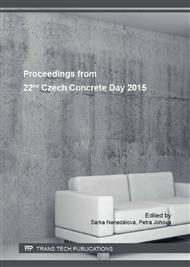p.173
p.179
p.185
p.191
p.197
p.203
p.209
p.215
p.221
Model Uncertainties of FEM Nonlinear Analyses of Concrete Structures
Abstract:
Advanced numerical simulations are more often used due to the increasing possibilities of computer technology. For material descriptions, generally nonlinear constitutive relations are employed. It is expected that in the near future the reliability of structures will be assessed by use of these sophisticated calculations. For this purpose, it is firstly necessary to evaluate the model uncertainty of the numerical model, because the structural reliability is directly affected by the model uncertainty. Recommended values of model uncertainties differ in individual scientific literary sources. In standard codes the partial safety factor for model uncertainty is set by relatively low value. This value was assessed by empirical way and it seems that such value is valid only for flexural failure. Contemporary numerical simulations indicate larger model uncertainties. Moreover, the value of model uncertainty should be related to particular failure mode. This paper presents a comprehensive procedure for the determination of model uncertainties of nonlinear analyses. In the second part, the value of model uncertainties is derived for punching of slabs.
Info:
Periodical:
Pages:
197-202
Citation:
Online since:
April 2016
Authors:
Price:
Сopyright:
© 2016 Trans Tech Publications Ltd. All Rights Reserved
Share:
Citation:


